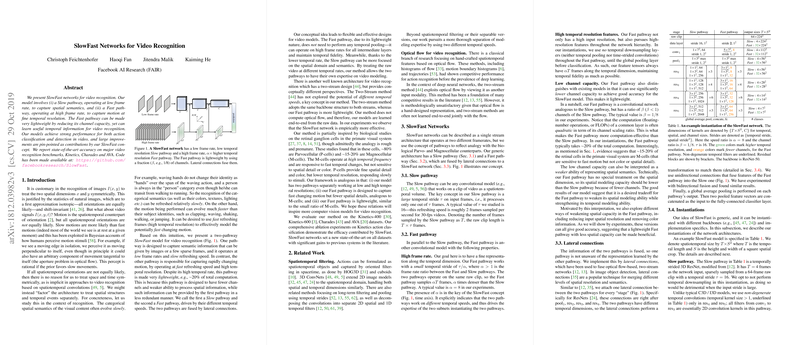SlowFast Networks for Video Recognition
Introduction
The paper introduces the SlowFast network architecture for video recognition. This model comprises two distinct pathways: a Slow pathway operating at a low frame rate to capture spatial semantics, and a Fast pathway operating at a high frame rate to capture fine-grained motion information. This duality leverages the complementary strengths of high temporal and spatial resolution, achieving state-of-the-art performance on major video recognition benchmarks.
Architecture Design
The Slow pathway, designed to process fewer frames, captures detailed spatial information. Meanwhile, the Fast pathway processes more frames, focusing on dynamic motion while being computationally lightweight due to reduced channel size. This division allows the Fast pathway to enhance temporal fidelity without excessive computational burden.
Key Components
- Slow Pathway: Processes one frame out of every frames (e.g., =16), thus focusing on spatial information over time.
- Fast Pathway: Samples at a higher frame rate (e.g., every 2 frames) but with fewer channels, concentrating on transient motion dynamics.
- Lateral Connections: These connections fuse information from the Fast to the Slow pathway, ensuring that high-temporal-resolution features enhance the spatially rich features of the Slow pathway.
Methodology
Training and Inference
The training from scratch approach distinguishes this work from many existing models that leverage ImageNet pre-training. The authors adopted a synchronized SGD training regime, utilizing a cosine learning rate decay schedule. For inference, the model samples 10 clips from a video and performs spatially center-cropped evaluations to maintain computational efficiency.
Datasets
Evaluations were conducted on Kinetics-400, Kinetics-600, Charades, and AVA datasets. These datasets provide a comprehensive benchmark suite, covering short-term actions and long-term activities, as well as spatially localized atomic actions.
Performance and Results
Kinetics Datasets
The SlowFast models set new records on the Kinetics-400 and Kinetics-600 benchmarks. On Kinetics-400, the top-performing SlowFast variant achieved 79.8% top-1 accuracy, outperforming the nearest competitor by a significant margin. For Kinetics-600, the model maintained its competitive edge with 81.8% accuracy.
Charades
SlowFast models also demonstrated strong performance on the Charades dataset, with the best model attaining 45.2 mAP when pre-trained on Kinetics-600. This is notable given the multi-label nature of Charades, reflecting the model’s robustness in capturing long-range temporal dependencies.
AVA Action Detection
On the AVA dataset, which focuses on spatiotemporal action detection, the SlowFast model achieved a notable mAP improvement by 5.2 points over the baseline Slow model, emphasizing its strength in dynamic scene understanding. The best-performing model achieved 28.2 mAP on AVA v2.1, setting a new standard for action detection accuracy.
Ablation Studies
The paper includes comprehensive ablation studies to validate the design choices of the SlowFast architecture. Key findings include:
- Channel Capacity: The reduced channel capacity of the Fast pathway is crucial for maintaining computational efficiency without sacrificing accuracy.
- Lateral Connections: Different methods of lateral fusion (such as time-to-channel and time-strided convolution) were experimented with, highlighting the efficacy of the T-conv method.
- Weaker Spatial Inputs: Variants using grayscale, optically flowed, or time-difference frames were also tested, showing competitive results and validating the robustness of the SlowFast design.
Implications and Future Directions
Theoretical Implications
The dichotomy of slow and fast pathways in the SlowFast architecture aligns with principles observed in biological vision systems, specifically the Parvo- and Magnocellular pathways. This suggests promising avenues for future work exploring biologically inspired architectures in video recognition.
Practical Implications
Practically, the SlowFast architecture’s modest computational requirements relative to its performance make it a compelling choice for real-world applications, such as video surveillance, autonomous driving, and human-computer interaction, where both accuracy and efficiency are critical.
Future Developments
Future research can explore:
- Pathway Enhancement: Further enhancements to each pathway (e.g., dedicated modules for different motion types).
- Extended Fusion Techniques: Novel fusion techniques that dynamically adjust the contributions of each pathway based on the content.
- Cross-Modal Learning: Integrating audio and text modalities to improve context understanding in videos.
Conclusion
The SlowFast networks presented in this paper represent a significant advancement in video recognition, achieving state-of-the-art performance while maintaining computational efficiency. The architecture’s ability to balance spatial and temporal information offers a robust framework for future research and application in diverse video analysis domains.
